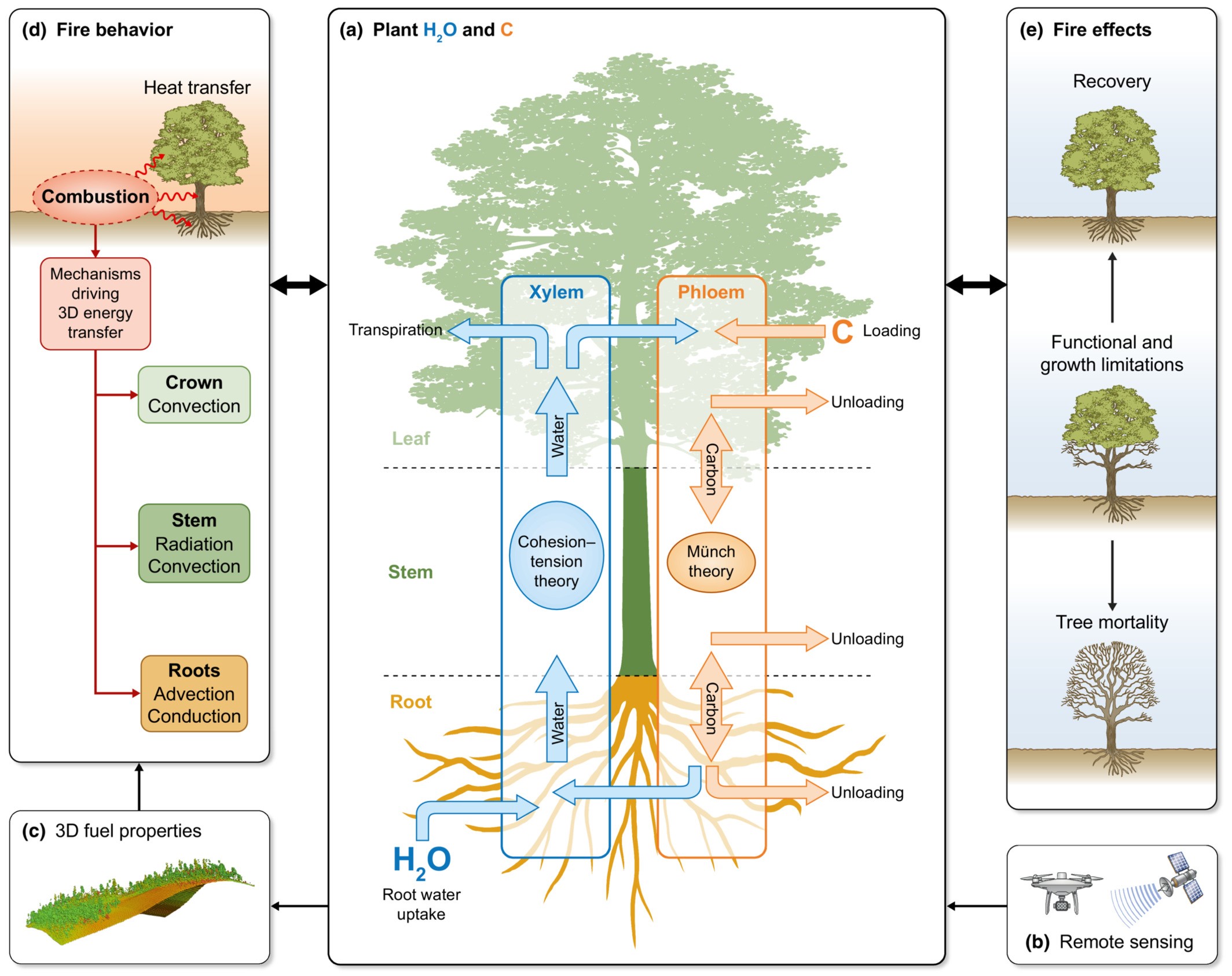January 24, 2023
Integrating Plant Physiology into Simulation of Fire Behavior and Effects
Plant water and carbon dynamics are important for fire behavior and effects.

Plant carbon (C) and water (H2O) dynamics are integrated into a model framework to allow exploration of biophysical mechanisms linking live vegetation to fire behavior and effects while capturing spatial variability across gradients.
[Reprinted under a Creative Commons Attribution 4.0 International License (CC BY 4.0) from Dickman, L. T., et al. "Integrating Plant Physiology into Simulation of Fire Behavior and Effects." New Phytologist 238 (3), 952–70 (2023). DOI:10.1111/nph.18770.]
The Science
The condition of living woody plants can change fire behavior. Plants have different levels of dryness throughout the seasons and in different parts of a landscape based on water and nutrients in the soil. Lower levels of live fuel moisture in plants have been linked to faster fires, changes in the way fires burn, and alter how likely plants are to die after a fire. Linking live fuel moisture measurements from remote sensing tools such as airborne systems to models of fire behavior and effects improves understanding of how fires may change in the future.
The Impact
Fire behavior models have long used general fuels in broad groups. With new types of models and remote sensing measurements of fuels and fires, researchers can capture more realistic fuels and how they change in both their structure and condition, such as live fuel moisture. This information is critical for fire management in conditions of drought and warming. Linking how living plants change through time and across a landscape to how fires might behave will provide information to better support communities in a world with more fire.
Summary
Wildfires have been recognized as a global crisis, but current fire models do not capture how living plants change in response to changing climate. With drought and warming temperatures increasing the importance of living plants in changing fire behavior, researchers can capture these complex processes and interactions with new model capabilities. This study provides a renewed focus on capturing live woody plants in fire models. Living plant conditions and properties influence fire combustion and heat transfer and often dictate if a plant will survive. These interactions provide a mechanistic link between living plants and fire behavior and effects that can be included in new models. This study includes a conceptual framework linking remotely sensed estimates of plant condition to models of fire behavior and effects, which could be a crucial first step toward improving models used for global fire forecasting. This process-based approach will be essential to capturing the influence of physiological responses to drought and warming on live fuel conditions, strengthening the science needed to guide fire managers in an uncertain future.
Principal Investigator
Jacquelyn Shuman
University Corporation for Atmospheric Research
[email protected]
Program Manager
Brian Benscoter
U.S. Department of Energy, Biological and Environmental Research (SC-33)
Environmental System Science
[email protected]
Funding
Support was received from:
- Los Alamos National Laboratory (LANL) through its Center for Space and Earth Science, which is funded by LANL’s Laboratory Directed Research and Development (LDRD) program under project no. 20210528CR;
- LANL LDRD project no. 20210689ECR;
- Strategic Environmental Research and Development Program (SERDP) project RC18-1346;
- Natural Sciences and Engineering Research Council of Canada (NSERC) Discovery Grant;
- Austrian Science Fund (FWF, project P32203);
- University of Innsbruck (Early-Stage Funding, grant W-171705);
- Australian Research Council;
- Australian Research Data Commons;
- SmartSat Cooperative Research Centre;
- Singtel Optus Pty Limited;
- National Center for Atmospheric Research, a major facility sponsored by the National Science Foundation (NSF) under Cooperative Agreement no. 1852977;
- NASA Arctic Boreal Vulnerability Experiment Grant 80NSSC19M0107;
- Next-Generation Ecosystem Experiments Tropics (NGEE Tropics), which is funded by the U.S. Department of Energy’s (DOE) Office of Science, Biological and Environmental Research (BER) program;
- NASA Surface Biology and Geology Mission Study (NNG20OB24A);
- U.S. DOE contract no. DE-SC0012704 to Brookhaven National Laboratory;
- U.S. Department of Defense (DoD) SERDP Project RC19-1119;
- NSF WIFIRE Commons grants 2040676 and 2134904;
- Ministry of Science and Innovation projects RTI2018-094691-B-C31; EU H2020 (grant agreements 101003890);
- U.S. DoD SERDP’s Closing Gaps Project RC20-1025;
- U.S. Department of Agriculture Forest Service personnel were supported by annual Forest Service appropriations.
References
Dickman, L. T., et al. "Integrating Plant Physiology into Simulation of Fire Behavior and Effects." New Phytologist 238 (3), 952–70 (2023). https://doi.org/10.1111/nph.18770.

